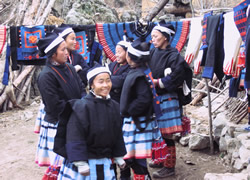Li Hu, Nandan - a place of beauty and wonder.
 Whenever Baiku Yao is mentioned, images of hill villages enshrouded in clouds and fog, the simplicity of the people, their colourful costume, the penetrating and reverberating copper drum, and the dignified religious and burial customs all come to mind. Baiku Yao is addressed by the local Han people as “yao lao geng” or “yao lao tong” (both “lao geng” and “lao tong” mean sworn brothers or sisters). Even today, Baiku Yao is attracting curiosity, envy and dispute mainly because it is perceived as stubbornly holding on to traditional roots. The people of Baiku Yao do not rely on literature alone to recall it’s history. Instead they keep a close relationship with their heritage and history through their actions and practices. Generation after generation, Baiku Yao people pass on their traditional lifestyle. In an era when past practices are usually forgotten, where else can one find such a strong spirit of stubbornness?
Whenever Baiku Yao is mentioned, images of hill villages enshrouded in clouds and fog, the simplicity of the people, their colourful costume, the penetrating and reverberating copper drum, and the dignified religious and burial customs all come to mind. Baiku Yao is addressed by the local Han people as “yao lao geng” or “yao lao tong” (both “lao geng” and “lao tong” mean sworn brothers or sisters). Even today, Baiku Yao is attracting curiosity, envy and dispute mainly because it is perceived as stubbornly holding on to traditional roots. The people of Baiku Yao do not rely on literature alone to recall it’s history. Instead they keep a close relationship with their heritage and history through their actions and practices. Generation after generation, Baiku Yao people pass on their traditional lifestyle. In an era when past practices are usually forgotten, where else can one find such a strong spirit of stubbornness?
If there had not been any intervention from foreign cultures, Baiku Yao would be a happy people according to the happiness index. Though there was suffering brought on by poverty, they found refuge in their spirituality and the support within the community was at its strongest. If we abandon all that we are born with, and seek to imitate the lifestyle of mainstream society without reflecting on our roots, we will become a prodigal son wandering far from home. We will be the last group of people who follow mainstream society, as our own heritage gradually dies away. Without reflecting on our personal culture and values, everyday may evoke the emptiness of not belonging anywhere.
One of the reasons PCD launched its project for Baiku Yao is because of its traditional and close community. With social change and the development of transportation, Baiku Yao has gradually come into contact with the outside world. However, in the process, many issues and barriers have emerged. Since the community is very different from the outside world, it faces the problem of how to express itself and communicate without compromising on its unique identity. The relative poverty in Baiku Yao, compared to the material wealth of the local Han people, has resulted in a divide that makes some Baiku Yao people feel inferior.
One of the partner communities for the project is Wang Shang Village at Yao Zu Township in Li Hu, Nandang. There are 97 households and a total population of over 300. However, due to the unavoidable trend of young people looking for work in cities, only women, children, middle-aged and elderly men remain in the community. In our cultural programme, we encourage the villagers to revive some cultural activities that are under threat of extinction, such as learning traditional music instruments, holding special religious rituals, and story-telling by elderly people to children. In our exchange with women, we learnt that they wanted to learn the Han language and some arithmetic. After a month of study, we started an evening class in the village. We began teaching what the women needed most and what they were interested in, and integrated real-life scenarios in the learning process. It was hoped that by enhancing female villagers’ ability to communicate with the outside world, their self-confidence and participation in the management of community affairs would also be enhanced. By referring to texts on the traditional culture of Baiku Yao, the women were able to learn from that experience and heighten their awareness of their own culture vis-à-vis that of the dominant mainstream. As such, they will be more prepared when faced with the inevitable development of tourism, and their culture will be less vulnerable.
In the short duration of the programme, the women may not be able to acquire a vast amount of knowledge, but this is just the beginning. Seeing their smiles filled with hope and the effort they have been making, we hope that the evening classes can provide them with the strength to support their village. We noticed that a few women have begun to play a key role in activities on cultural transmission and in the management of community affairs. This could become an example for other hill villages to learn from. In 2008, women took over the roles of cashier and accountant in the project management committee. Their ability in managing small funds was not at all inferior to the management committee in the previous two terms. Just like the men, the women have also taken part as community artists in the cultural transmission class for primary school students.
Once a woman told the visitors: “The clothes of the outside world are beautiful, but our clothes look just as good.” Watching her subtle smile, we were all moved. I thought that this should be the kind of thing that motivates us in carrying out cultural programmes in the village, and it should be one of the objectives of our study.
Li Xia (of Baiku Yao nationality, programme staff for the Nandang Cultural Programme)

